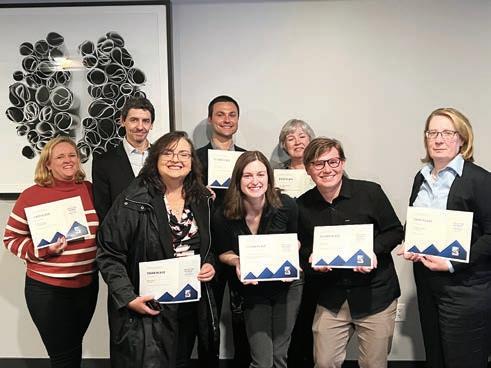
5 minute read
Colorado Community Media sta wins 8 awards
Current and former members of the Colorado Community Media sta celebrate eight awards at the annual Top of the Rockies event hosted by the Society of Professional Journalists. The competition includes submissions from professionals in New Mexico, Colorado, Wyoming and Utah.
SPJ competition featured news from four states




Staff Report
Colorado Community Media sta netted eight awards during the annual Top of the Rockies contest hosted by the Society for Professional Journalists, or SPJ, in downtown Denver on April 22.

With 24 newspapers across the Front Range, CCM reporters competed in the “Large Newsroom” category, which included larger publications and outlets from Colorado, Utah, New Mexico and Wyoming.
CCM had two rst-place honors. Evergreen reporter Deb Hurley Brobst took the top honors in the category of Obit Reporting for her article on Mandi Evans, who “gave more to the community than great food.”
South Metro Editor elma Grimes took rst place in the Mental Health writing category for a series she and two high school interns wrote in 2022. e “Need to Succeed” series broke down how the combination of college costs, social media and parent and societal expectations is costing kids their childhoods.
Several CCM sta members won second-place honors.
Luke Zarzecki took second place in the Feature: Long Form category for his story titled, “Uprooting the American dream: Opinions changing about lush lawns.” county heard concerns that the change “would make the process for someone to amend a planned development much easier or to get a development of a di erent type approved much easier — that it would be a signi cant thing,” said Steven Koster, assistant director of planning services for Douglas County. “And I’m not sure exactly how that understanding came to be.”
For general reporting in a series or package, several south metro sta members combined for a secondplace award. Former reporters Jessica Gibbs and Elliott Wenzler along with Grimes and current CCM reporter McKenna Harford took an extensive look throughout 2022 at the Douglas County School District’s termination of former superintendent Corey Wise.
In Enterprise Reporting, former Littleton reporter Robert Tann won for his in-depth look at police chases that span over Douglas and Arapahoe counties.
Arvada Reporter Rylee Dunn won third place for her in-depth look at parents in the Je erson County School District. Dunn’s article, “Inside Je co Kids First, and Ganahl’s furor over students,” won in the Education: News category.
For extended coverage, CCM’s Digital Editor Deborah Grigsby won third-place honors for her coverage of mobile home legislation in 2022.
In design, CCM’s Tom Fildey won third place for Single Page Design where he featured a photo page of a wild re impacting bighorn sheep.



‘Meant to be flexible’
An area with “planned development” zoning can feature a mix of property types — including residential, commercial, recreational and others — in a way that standard zoning districts can’t, Koster said.
Planned developments are also intended “to encourage innovative and creative design,” Douglas County’s zoning policy says.

Planned developments can be small or spread over a large area: Highlands Ranch is a planned development, for example.
Over time, planned developments can change, or be “amended,” if the county gives the OK. At issue during the April 17 county Planning Commission meeting was a proposal to edit the criteria that would allow for those changes.

Among several approval criteria, the sta held up two for edits. ey included:


• A change from the wording “Whether the amendment is consistent with the development standards, commitments, and overall intent tent with the intent, e cient development and preservation of the entire planned development” to “Whether the amendment is consistent with the e cient development of the entire planned development.” at may sound like dry, inconsequential language. But the proposed removal of some words — particularly “preservation” — raised some residents’ eyebrows.
“For some county developments numerous residents have been in place for decades,” Tim Knaus, of the Roxborough Park area, wrote to the county. “Lifelong decisions regarding how they would live depended on the planned development. Preservation must be addressed.”
In a report to the county Planning keeping the planned development in (its current) state,” Matt Jakubowski, a chief planner on county sta , said during the meeting.
But “by the very fact” that a developer ever proposes to amend a planned development, that inherently implies change, he said.
“ ey’re meant to be exible — they’re not meant to be a fossil,” Jakubowski said.
‘ e soul of Douglas County’
County residents expressed fears of “high-density” multifamily buildings — a term that often means apartments. (“Density” is a term for how many people or housing units occupy an area.)
Area resident Evelyn Zur framed the backlash at the meeting as “ ght-
“What we’re talking about here with the zoning change is allowing more apartments, more renters. When you have a majority of (home) ownership in a county, you have a quality county. When you have a majority of renters, that quality gets diluted,” Zur said at the meeting.
“ ere’s a reason people move here,” said resident Holly Green, who warned of “an erosion of our property rights.”
Another commenter saw the changes in a larger context, saying “our freedoms, our liberties, our rights” are at risk.
Asked whether the proposed language edits would lead to more new, high-density multifamily buildings in longtime single-family neighborhoods, Koster told Colorado language — parks structed, tions of where planned considered it ing tial the regulations edited. ber, to tion those




Community Media: “I don’t think it changes the probabilities around that happening, no.” e concept of “preservation” is mentioned elsewhere in Douglas County’s zoning rules regarding planned developments, such as in saying: “Development within this district should be designed to … ensure that environmentally and visually sensitive areas are preserved.”
“ ere are more than just those two approval criteria,” Koster said.
‘Overall intent’ e county’s existing zoning regulations already mention the possibility of changes to commitments in cases where a developer asks to change a planned development.
Also mentioned in the proposed language change are “commitments” — agreements a developer makes to donate land for a school, allow for parks to be built or have roads constructed, for example.
“An amendment request shall be considered a major amendment if it meets one or more of the following criteria (including) … Substantial changes to … commitments,” the zoning rules say in a part of the regulations that aren’t proposed to be edited.
Jakubowski, the county sta member, said the parts that are proposed to be edited would no longer mention commitments “not because those things aren’t important.”

But, for example, if there were a type of boundary that a developer asked to change, that would not concern a commitment, Jakubowski said.
“ e idea is to go back to the overall intent of the planned development,” Jakubowski said.
Extreme changes to a planned development wouldn’t depend on the language that county sta are proposing editing.
“ ere does come a point where the changes somebody wants to make are too fundamental,” and then “we would say that the proper (process) is a full rezoning” rather than mere tweaks based on the planned development rules, Koster told CCM.








